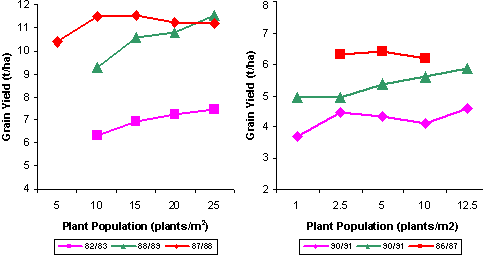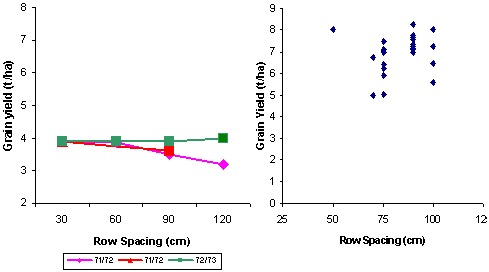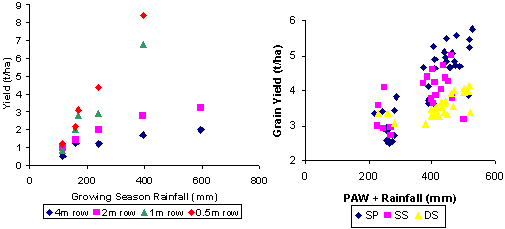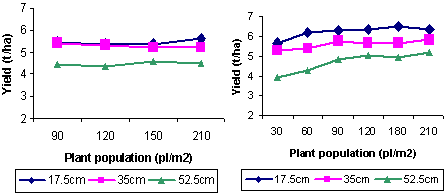Population density studies in sorghum and wheat
Author: Giles Butler, Bill Manning, Loretta Serafin | Date: 19 Sep 2003
What are the impacts of varying populations and row configuration?
Giles Butler
NSW Agriculture Tamworth Agricultural Institute
Ph (02) 67631100
giles.butler@agric.nsw.gov.au
Bill Manning
NSW Agriculture Tamworth Agricultural Institute
Loretta Serafin
NSW Agriculture Gunnedah
GRDC Project Code: DAQ00050
*Note - this report may contain independently supported projects which complement the work in this GRDC research program.
Take home messages
- Plant population and row spacing responses on the Liverpool Plains are likely to be lower than elsewhere in northern NSW due to the relatively cooler and wetter environment and higher water holding capacity of the majority of soils.
- Plant population in sorghum should not be less than 50000 established plants/ha and row spacing should be 1m or less.
- Plant population in wheat should be around 100-150 plants/m2 and row spacing should be less than 30-40 cm.
Introduction
The impact of row spacing and plant population on the grain yield of wheat and sorghum will vary depending on a range of factors including cumulative temperature starting soil water total in-crop rainfall and especially available soil moisture at flowering and grain fill.
However generally higher plant populations and narrower row spacings are recommended for higher rainfall areas like the Liverpool Plains. In conditions where moisture stress is minimal maximum grain yield is achieved when leaf area is maximised.
This generally occurs with higher plant populations and narrower row spacing as this enables each plant to grow freely for the longest period before it encounters competition from other plants for light and other resources (e.g. nutrients and water).
However having said this the response curve in wheat and sorghum is often flat as both crops have the capacity to compensate through tillering. This effect is more common when plant population as opposed to row spacing is adjusted.
A review by de Wit (1977) concluded that the optimum density range for grain yield is wide in crops with terminal inflorescences and a large capacity to produce tillers at normal crop densities.
Myers and Foale (1981) also concluded that the lack of a consistent relationship between plant population and yield is likely due to the compensatory capacity of tillering plants such as sorghum.
The impact of row spacing on grain yield can be more significant especially when using wider rows (greater than 1m in sorghum and 0.5m in wheat) due to the inability of the plant canopy to completely cover the ground area which in high yielding situations limits potential yield.
Changing plant population and row spacing have different but interacting effects on the use of available resources that will eventually determine yield.
Plant population determines the number of individuals which the limiting resources must be shared between whilst plant arrangement (incorporating row spacing) controls the interception or retrieval of those resources (Jones 1987).
Altering row spacing affects light interception and timing of soil moisture use (Myers and Foale 1981). Response to row spacing depends on the relation between flowering time of the crop and water supply. There is a critical relation between availability of water and time of flowering in dryland crop production (Fukai and Foale 1988).
Sorghum Plant Population and Row Spacing
Most sorghum crops are sown into sufficient moisture for the plant to reach the early reproductive stage of development without suffering significant moisture stress.
This implies that tillering has been determined and the plant will respond to moisture stress during the flowering and grain filling stage by manipulating the grain components of yield. The plant has the capacity to manipulate yield components grain size and grains per panicle during the flowering and grain filling period.
However the most sensitive component of yield is the number of grains per panicle and indicates that flowering and grain filling time is a major period of competition for moisture (Thomas et al 1981). The overall season especially in terms of water availability and its interaction with plant population and row spacing will potentially have a significant impact on grain yield.
Repeated row spacing and population studies in sorghum have often failed to establish optimum row spacing and plant population estimates (Myers and Foale 1981).
However some past research has resulted in estimating desirable plant population in sorghum. Thomas et al (1981) suggested a plant population of 60000-80000 plants/ha. Thomas et al (1980) indicated a plant population of around 85000 plants/ha should be optimal.
Maximum yield for a range of hybrids at each yield level did not differ significantly from yield at a density of 75000 plants/ha (Wade and Douglas 1990). They suggested highest grain yields would be obtained with a plant population between 50000-100000 plants/ha under dryland conditions. These results indicated plant population of dryland sorghum on the Liverpool Plains should be around 50000-80000 plants/ha.
Trials conducted by Tony Dale in the 1980's on the Liverpool Plains suggest plant population for irrigated sorghum should be upto 250000 plants/ha and about 50000 plants/ha under dryland situations (Fig 1) although a survey of sorghum paddocks conducted in 2002/03 did not indicate any significant relationship between plant population and yield with population ranging from 30000 to 60000 plants/ha.
However it is still concluded that a plant population of at least 50000 plants/ha should be established for dryland sorghum production on the Liverpool Plains.
At sites with a low yield level grain yield increases with increased row spacing. Where the site yield was high due to favourable conditions an increase in row spacing reduced yield (Holland and McNamara 1982).
Early research concluded narrow rows (0.35m) had a greater yield potential than wider rows (0.7 or 1.0 m rows) under favourable conditions but was also more susceptible to crop failure under water stress (Bygott (1956). Results from Holland and McNamara (1982) suggest increasing row spacing from 0.3 m to 1.20 m can reduce yields (Fig 2). A survey of sorghum paddocks in 2002/03 did not show any significant relationship between grain yield and row spacing (Fig 2). Wade et al (n.d.) (Fig 3) indicates when growing season rainfall is greater than about 200 mm and grain yield is around 3 t/ha yield losses are likely from a row spacing wider than 0.5m. From all these findings it is concluded a row spacing of less than 1m should be used on the Liverpool Plains.
Growing sorghum using skip row configurations has been successful in stabilising sorghum grain yield in western cropping zones. This technology uses the rationale that the suppression of early plant growth and leaf area is likely to improve water use efficiency of dryland grain sorghum grown on stored soil water by promoting plant competition by changing the arrangement of plants in the field (Blum and Naveh 1976).
Basically by maintaining plant population on an area basis and widening row spacing early plant competition is increased reducing plant drymatter and water use with the added benefit of saving soil water in the 'skipped' area for use by the plant during flowering and grain fill.
On the Liverpool Plains the reduction in drymatter as a result of skip row configurations (using an equivalent 1m row spacing) will most likely reduce grain yield considering average yield potential is at least 4 t/ha on the Plains and yield loss probably starts around 3 t/ha (Fig 3).
Finally wider row spacings and higher plant populations will result in a more even and shorter flowering period and harvest due to reduced tillering (Thomas et al 1980).
Also there is certainly a trend in sorghum for wider rows to increase grain size although this is not generally reflected in grain yield (Thomas et al 1980).
However the loss of $10/t due to higher screenings at $150/t for a 5t/ha crop only requires a yield improvement of 0.35 t/ha to negate any advantage. This suggests widening row spacing for grain quality benefits is unlikely to be worthwhile.
Similarly reducing sowing rate to save costs may actually prove costly. A difference in plant population of 20000 plants/ha assuming a 1000 grain weight of 25g (ie 40000 seeds/kg) and seed cost of $5/kg would only cost $2.50/ha.
This indicates that it is uneconomic to reduce plant population if grain yield increases by only 0.02 t/ha as a result of the additional plant population (using $150/t). These two examples illustrate that although the response surface for grain yield is likely to be fairly flat when plant population and row spacing are changed the overall cost of being conservative may be significant.
Figure 1 Impact of plant population on sorghum grain yield under (a) irrigation and (b) dryland conditions on the Liverpool Plains. Source Dale T. (Unpublished)

Figure 2 Effect of row spacing on grain yield on the Liverpool Plains and Tamworth (a) and (b) sorghum paddock data 2002/03. Source Holland and McNamara (1982)

Figure 3 Impact of row spacing on yield as influenced by available water (a) Source Wade et al (n.d.) and (b) data from skip row sorghum research by Butler G.

Wheat Plant Population and Row Spacing
The philosophy underpinning the response of wheat to plant population and row spacing is similar to sorghum. The grain yield response will differ depending on the season. Similar to sorghum the reason behind the desire to adjust population and row spacing in wheat is risk management. Again as the growing conditions are generally very favourable it is highly likely that higher plant population and narrower rows will result in higher grain yield.
Response to plant population around Australia under dryland and irrigated conditions is relatively flat once population reaches about 90 plants/m2.
Sheppard et al (n.d.) concluded plant densities should be in the range 100 to 150 plants/m2 in Queensland. Optimal plant density generally ranged between 100 and 200 plants/m2 in Western Australia (Anderson 1986). Doyle (1980) suggested an optimal sowing rate of 60 kg/ha (about 120 plants/m2) in northern NSW.
A plant population of around 100 plants/ m2 was shown to be optimal for the Liverpool Plains (Fig 4) in trials conducted in 2000 and 2001 with durum wheat. Therefore it is highly likely that plant population should be somewhere in the range 100 to 150 plants/m2.
Population rather than sowing rate should be used for planting as illustrated by Anderson (1986) where the sowing rate necessary to achieve a plant population of 200 plants/m2 varied from 66 to 138 kg/ha depending on seed size and establishment losses.
Research in WA suggested there was no yield benefit from reducing row spacing below 18 cm (Yunusa et al 1993) although yield levels were only between 1 to 2.5 t/ha. Irrigated wheat trials at Griffith showed that plant spacing through variations in row spacing (17-45cm) or sowing rate (~100-400 plants/m2) did not significantly affect grain yields at yield levels around 4.5 - 5.5 t/ha (Stapper and Fischer 1990).
Doyle (1980) found that increasing row spacing from 18 cm to 36 cm reduced yield by ~10% in wheat trials conducted at Tamworth from 1974 - 1978.
He also found that generally there was no yield loss using 27 cm rows with yield ranging from about 1.5 to 3.5 t/ha.
Research in Europe and America suggested a yield loss of 5 - 10 % by increasing row spacing to 30 cm (Holliday 1963).
Fawcett (1967) estimated that yield was reduced by around 17 kg/ha for each cm increase in row spacing from 18 to 90 cm from research conducted at Narrabri.
A row spacing of 35 cm could reduce grain yield in trials conducted on the Liverpool Plains in 2000 and 2001 using durum wheat (Fig 4). These findings suggest a row spacing greater than 30-40 cm will likely reduce wheat grain yield.
Figure 4 Impact of plant population and row spacing on durum wheat grain yield in 2000 and 2001 on the Liverpool Plains.

Conclusion
The response curve for plant population in sorghum and wheat on the Liverpool Plains is relatively flat at normal plant densities.
Past research and grower experience would show that acceptable grain yields can be achieved with low plant population but to enable a high yield to be achieved (likely on the Liverpool Plains) a plant population over 50000 plants/ha for sorghum and 100 plants/m2 for wheat is suggested.
Row spacing in sorghum should be a solid plant on a row spacing less than 1m and less than 30-40 cm for wheat.
References
Anderson W.K. (1986). Aust. J. Agric. Res. 37 219-33.
Yunusa I.A.M. Belford R.K. Tennant D. and Sedglery R.H. (1993). Aust. J. Agric. Res. 44 661-76.
Stapper M. and Fischer R.A. (1990). Aust. J. Agric. Res. 41 1021-41.
Doyle A.D. (1980). The J. of the Aust. Inst. Agric. Sc. p125-127.
Holliday R. (1963). Field Crop Abstr. 16 71-81.
Fawcett R.G. (1967). Ph.D. Thesis Univ. Syd.
De Wit C.T. van Laar H.H. and van Keulen H. (1977). Plant Breed. Perspectives p47-82.
Jones M.J. (1987). Exp. Ag. 23 335-47.
Wade L.J. and Douglas A.C.L. (1990). Aust. J. Exp. Ag. 30 257-64.
Bygott R.B. (1956). Qld. Ag. J. 82 581-584.
Thomas G.A. French A.V. Ladewig J.H. and Lather C.J. (1980). Qld. J. Ag. Anim. Sc. 37 67-77.
Holland J.F. and Mcnamara D.W. (1982). Aust. J. Exp. Agric. Anim. Husb. 22 310-316.
Fukai S. and Foale M.A. (1988). Aust. J. Exp. Ag. 28 771-77.
Myers R.J.K. and Foale M.A. (1981). Field Crops Res. 4 147-154.
Thomas G.A. et al (1981). Aust. J. Exp. Ag. Anim. Husb. 21 210-217.
Blum A. and Naveh N. (1976). Agron. J. 68 111-116.
Wade L.J. Myers R.J.K. and Foale M.A. (n.d.) Climatic Risk in Crop Production.
GRDC Project Code: DAQ00050,
Was this page helpful?
YOUR FEEDBACK
